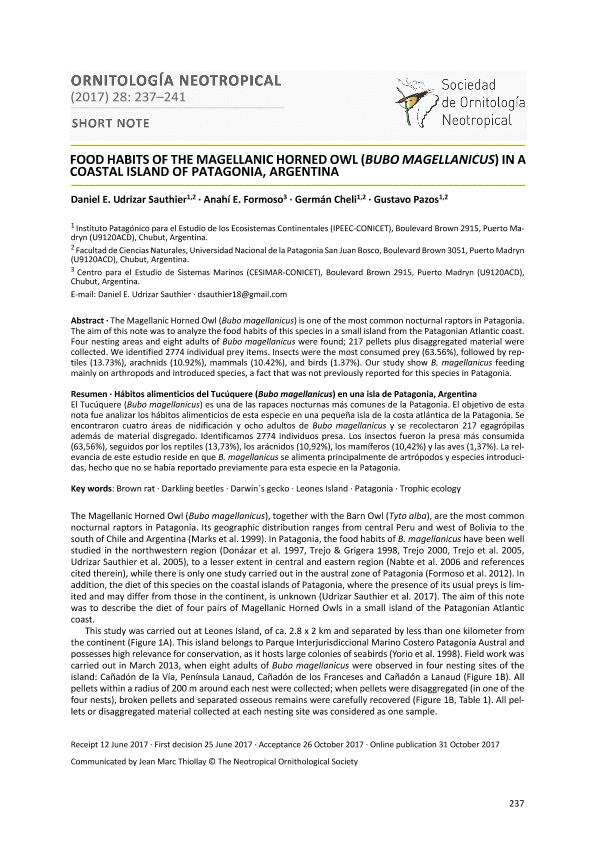Artículo
The Magellanic Horned Owl (Bubo magellanicus) is one of the most common nocturnal raptors in Patagonia.The aim of this note was to analyze the food habits of this species in a small island from the Patagonian Atlantic coast.Four nesting areas and eight adults of Bubo magellanicus were found; 217 pellets plus disaggregated material werecollected. We identified 2774 individual prey items. Insects were the most consumed prey (63.56%), followed by rep‐tiles (13.73%), arachnids (10.92%), mammals (10.42%), and birds (1.37%). Our study show B. magellanicus feeding mainly on arthropods and introduced species, a fact that was not previously reported for this species in Patagonia. El Tucúquere (Bubo magellanicus) es una de las rapaces nocturnas más comunes de la Patagonia. El objetivo de esta nota fue analizar los hábitos alimenticios de esta especie en una pequeña isla de la costa atlántica de la Patagonia. Se encontraron cuatro áreas de nidificación y ocho adultos de Bubo magellanicus y se recolectaron 217 egagrópilas además de material disgregado. Identificamos 2774 individuos presa. Los insectos fueron la presa más consumida (63,56%), seguidos por los reptiles (13,73%), los arácnidos (10,92%), los mamíferos (10,42%) y las aves (1,37%). La rel‐ evancia de este estudio reside en que B. magellanicus se alimenta principalmente de artrópodos y especies introduci‐ das, hecho que no se había reportado previamente para esta especie en la Patagonia.
Food habits of the Magellanic Horned Owl (Bubo magellanicus) in a coastal island of Patagonia, Argentina
Título:
Hábitos alimenticios del Tucúquere (Bubo magellanicus) en una isla de Patagonia, Argentina
Udrizar Sauthier, Daniel Edgardo ; Formoso, Anahí Elizabeth
; Formoso, Anahí Elizabeth ; Cheli, German Horacio
; Cheli, German Horacio ; Pazos, Gustavo Enrique
; Pazos, Gustavo Enrique
 ; Formoso, Anahí Elizabeth
; Formoso, Anahí Elizabeth ; Cheli, German Horacio
; Cheli, German Horacio ; Pazos, Gustavo Enrique
; Pazos, Gustavo Enrique
Fecha de publicación:
10/2017
Editorial:
Neotropical Ornithological Society
Revista:
Ornitologia Neotropical
ISSN:
1075-4377
Idioma:
Inglés
Tipo de recurso:
Artículo publicado
Clasificación temática:
Resumen
Archivos asociados
Licencia
Identificadores
Colecciones
Articulos(CESIMAR)
Articulos de CENTRO PARA EL ESTUDIO DE SISTEMAS MARINOS
Articulos de CENTRO PARA EL ESTUDIO DE SISTEMAS MARINOS
Citación
Udrizar Sauthier, Daniel Edgardo; Formoso, Anahí Elizabeth; Cheli, German Horacio; Pazos, Gustavo Enrique; Food habits of the Magellanic Horned Owl (Bubo magellanicus) in a coastal island of Patagonia, Argentina; Neotropical Ornithological Society; Ornitologia Neotropical; 28; 10-2017; 237-241
Compartir



